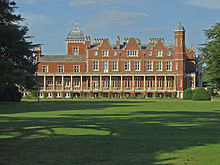Babraham Institute
 | |
| Formation | 1948 |
|---|---|
| Location |
|
Director | Simon Cook |
Key people | |
| Affiliations | |
Staff | ~350 |
| Website | www |
Formerly called |
|



TheBabraham Instituteis a life sciences research institution focussing on healthy ageing. The Babraham Institute is based on the Babraham Research Campus, partly occupying a former manor house, but also laboratory and science facility buildings on the campus, surrounded by an extensive parkland estate, just south ofCambridge,England.It is an independent and charitable organization which is involved in biomedical research, including healthy aging and molecular biology. The director is Dr Simon Cook who also leads the Institute's signalling research programme.
The Babraham Institute is a member of EU-LIFE, an alliance of leading life sciences research centres in Europe.[1]It is also a partner organisation of theUniversity of Cambridge
History[edit]
The institute is located on the historic Babraham Hall Estate (now called the Babraham Research Campus), situated six miles south-east ofCambridge University,near theGog Magog Hills.It is close to where the ancient RomanVia Devanacrossed the prehistoricIcknield Way.The estate includes Babraham Hall, designed in theJacobean stylebyPhilip Hardwick,which was built between 1832 and 1837. The hall was purchased by the Agricultural Research Council (ARC) in 1948 at the suggestion of ProfIvan De Burgh Daly,[2]together with 182 hectares of farm and woodland to become the Institute of Animal Physiology, Babraham.[3][4]
A department of biochemistry was established in 1954 bySir Rudolph Peters FRS,who had just retired fromOxford University.He invitedRex Dawsonto join him the following year.
In 1986, The Institute of Animal Physiology was joined with two Scottish institutes based atRoslin,The Animal Breeding Research Organisation (ABRO) and the Poultry Research Centre, to form The Institute of Animal Physiology and Genetics Research (IAPGR) funded by theAgricultural and Food Research Council(AFRC). In 1993, Roslin and Babraham formed two separate institutes, at which time the Babraham Institute assumed its current name. in 1994, The AFRC was disbanded and TheBiotechnology and Biological Sciences Research Council(BBSRC) was formed. All work with direct relevance to agriculture ceased in 1998.
Research[edit]
The aim of the research conducted at The Babraham Institute is to study the molecular mechanisms that underlie normal cellular processes and functions, and to understand how these systems are affected by age. The Institute's work also covers how faults or abnormalities in these systems may contribute to disease. The Institute has the status of a postgraduate department within theUniversity of Cambridgeand trainsPhDstudents who are registered with the University's Faculty of Biology. The research laboratories of the Institute are structured around three strategic programmes:
- Signalling(headed by Simon Cook): focuses on proteins that play a critical role in controlling communication between and within cells. These proteins make up thesignalling pathwaysthat organise how cells and organs develop and react to their environment.
- Immunology(headed byMartin Turner): investigates signal transduction pathways that regulate the survival and activation of lymphocytes.
- Epigenetics(headed by Gavin Kelsey): studies how epigenetic information is introduced into the genome during early development of an organism, which can in part depend on environmental or nutritional factors acting through cell signalling pathways.
Research breakthroughs made at the Babraham Institute include the discovery ofliposomesbyAlec Bangham,[5]the role ofInositol trisphosphatein the release ofcalciumfrom intracellular stores byMichael Berridge,[6]the discovery thatgenomic imprintingwas carried by DNA methylation byWolf Reik.[7]
Many of its past and current employees were elected fellows of theRoyal Society,including (in date order) DrsSir Rudolph Albert Peters(1935),Ivan de Burgh Daly(1943),Sir John Henry Gaddum(1945),Marthe Vogt(1952),Richard Darwin Keynes(1959), Sir Barry Cross (1975),Rex Malcolm Chaplin Dawson(1981),Sir Robert Brian Heap(1989), M Azim Surani (1990), Robin Francis Irvine (1993), Jonathan Charles Howard (1995),Wolf Reik(2010),Len Stephens(2011),Phil Hawkins(2013).
Babraham Institute Enterprise Ltd (BIE),[8]the wholly owned trading subsidiary of the Babraham Institute promotes knowledge transfer and translation of the Institute’s research discoveries, actively managing and exploiting the Institute’s intellectual property, promoting and negotiating commercial research partnerships and establishing spin-out companies when appropriate.
Funding[edit]
The Institute's research programmes are primarily supported by Institute Strategic Programme Grants (ISPGs) awarded by theBiotechnology and Biological Sciences Research Council(BBSRC), part ofUK Research and Innovation.Additional grant funding comes from other research councils, such as theMRC,the Wellcome Trust,theEuropean Commission,charitable foundations and medical charities. Some industry funding supports collaborative research projects.
Directors[edit]
- 1949-1958 Ivan de Burgh Daly CBE, FRS
- 1958-1965Sir John Henry GaddumFRS
- 1965-1972Richard Darwin KeynesCBE, FRS
- 1973-1989 Sir Barry Albert Cross CBE, FRS
- 1989-1993Sir Robert Brian HeapCBE, FRS
- 1994-2005 Richard Dyer OBE
- 2005-2007 John Bicknell (acting director)
- 2007–2020Michael J O Wakelam
- 2020-2021Wolf ReikFRS (acting and then permanent director)
- 2021- 2022 Simon Cook (interim director)
- 2022- Simon Cook (director)
References[edit]
- ^"Our members".EU-LIFE.
- ^"Details 1132".Archived fromthe originalon 5 March 2016.Retrieved8 January2016.
- ^Daly, I. D. B. (1957). "A.R.C. Institute of Animal Physiology, Babraham, Cambridge".Proceedings of the Royal Society B: Biological Sciences.146(923): 194–205.Bibcode:1957RSPSB.146..194D.doi:10.1098/rspb.1957.0004.
- ^Donald William Butcher (1954) A Short History of Babraham Hall and the Babraham Estate. ASIN: B000WRZKK6
- ^Bangham, AD; Standish, MM; Watkins, JC (1965). "Diffusion of univalent ions across the lamellae of swollen phospholipids".J Mol Biol.13:238–252.doi:10.1016/s0022-2836(65)80093-6.PMID5859039.
- ^Berridge MJ and Irvine RF (1984) Inositol trisphosphate, a novel second messenger in cellular signal transduction.Nature312,315 - 321
- ^Reik, W; Collick, A; Norris, ML; Barton, SC; Surani, MA (1987). "Genomic imprinting determines methylation of parental alleles in transgenic mice".Nature.328(6127): 248–251.Bibcode:1987Natur.328..248R.doi:10.1038/328248a0.
- ^"Babraham Institute Enterprise Ltd - Babraham Research Campus, Babraham, Cambridge, United Kingdom".Retrieved31 August2011.

